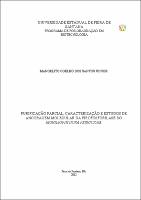| ???jsp.display-item.social.title??? |


|
Please use this identifier to cite or link to this item:
http://tede2.uefs.br:8080/handle/tede/991| ???metadata.dc.type???: | Dissertação |
| Title: | Purificação parcial, caracterização e estudos de ancoragem molecular da pirofosforilase do moniliophthora perniciosa |
| ???metadata.dc.creator???: | Santos Junior, Manoelito Coelho dos  |
| ???metadata.dc.contributor.advisor1???: | Taranto, Alex Gutterres |
| ???metadata.dc.description.resumo???: | A enzima UDP-N-acetilglicosamina pirofosforilase de Moniliophthora perniciosa, fungo patogênico causador da doença vassoura-de-bruxa do Theobroma cacao, foi o foco central deste trabalho. A enzima foi purificada, caracterizada, e por fim, utilizando um modelo 3D da pirofosforilase foram realizados estudos de ancoragem molecular. A vassoura-de-bruxa causou grandes impactos na economia baiana. Consequentemente, medidas para o seu controle foram empregadas, porém sem muito sucesso. Assim, linhas de pesquisa envolvendo alvos mais específicos estão sendo desenvolvidas para a seleção de antifúngicos mais seletivos e economicamente viáveis. A enzima pirofosforilase apresenta características estruturais e funcionais diferentes em organismos eucariontes e procariontes, portanto, o desenvolvimento de inibidores para a mesma, deve ser baseado no organismo que se está estudando. A enzima do fungo M. perniciosa foi parcialmente purificada por precipitação com sulfato de amônio e cromatografia de gel filtração em Sephacryl S-200. A metodologia de superfície de resposta (MSR) foi usada para a obtenção do pH e temperatura ótima. Como resultado, quatro diferentes isoenzimas (PyroMp I, PyroMp II, PyroMp III e PyroMp IV) apresentaram pH ótimo na faixa de 6,9-8,4 e temperatura ótima variando entre 28 a 68°C. Com base nas características do substrados, foram selecionados dez inibidores, os quais foram refinados pelo método AM1. Estudos de ancoragem molecular entre estes compostos e a enzima foram realizados pelo programa Autodock Vina, seguido de refinamento por simulações de dinâmica molecular. Os resultados da ancoragem indicam que o reconhecimento molecular da enzima com o substrato foi principalmente por ligações hidrogênio entre os ligantes e os aminoácidos Arg116, Arg383, Gli381 e Lis408; e algumas poucas interações hidrofóbicas com os resíduos de Tir382 e Lis123. Dos compostos analisados, NAG5 apresentou melhor energia de ligação (-95,2kcal/mol). As próximas etapas para o controle da vassoura-de-bruxa envolvem a obtenção dos compostos estudados e os respectivos testes in vitro e in loco. |
| Abstract: | The enzyme UDP-N-acetylglucosamine pyrophosphorylase Moniliophthora perniciosa, pathogenic fungus that causes witches' broom disease in Theobroma cacao, was the central focus of this work. The enzyme was purified and characterized, finally, using a 3D model of pyrophosphorylase’s docking study was performed. The witches' broom caused deep impact in the Bahia economy. Consequently, measures for its control were used, but without success. Thus, several researches involving more specific targets are being developed for the selection of more selective and economically viable antifungal agents. The enzyme has pyrophosphorylase structural and functional characteristics in different eukaryotic and prokaryotic organisms, so the development of inhibitors to it, should be based on organism which is being studied. The enzyme of the fungus M. perniciosa was partially purified by ammonium sulfate precipitation and gel filtration chromatography on Sephacryl S-200. The response surface methodology (RSM) was used to obtain the optimal pH and temperature. As a result, four different isoenzymes (PyroMp I, PyroMpII, PyroMpIII and PyroMpIV) showed that the optimum pH range of 6.9 to 8.4, and temperature ranging between 28-68 ° C. Based on the characteristics of substrates and products ten inhibitors were selected, which were refined by AM1. Docking studies between these compounds and enzyme were performed by AutoDock Vina software, following of refinement by molecular dynamics simulations. The results of docking suggest that the molecular recognition of the enzyme with the substrate occur mainly by hydrogen bonds between ligands and Arg116, Arg383, Gli381, and Lis408 aminoacids; and few hydrophobic interactions with Tir382 and Lys 123 residues. Among the compound analyzed, the NAG5 showed the best binding energy (-95.2 kcal/mol). The next steps for the control of witches' broom involve the attainment of the compound studied and the respective in vitro and in loco tests. |
| Keywords: | Pirofosforilase Vassoura-de-bruxa Purificação Ancoragem molecular Pyrophosphorylase Witches’broom Purification Docking |
| ???metadata.dc.subject.cnpq???: | CIENCIAS BIOLOGICAS CIENCIAS BIOLOGICAS::BIOLOGIA GERAL |
| Language: | por |
| ???metadata.dc.publisher.country???: | Brasil |
| Publisher: | Universidade Estadual de Feira de Santana |
| ???metadata.dc.publisher.initials???: | UEFS |
| ???metadata.dc.publisher.department???: | DEPARTAMENTO DE CIÊNCIAS BIOLÓGICAS |
| ???metadata.dc.publisher.program???: | Mestrado Acadêmico em Biotecnologia |
| Citation: | SANTOS JUNIOR, Manoelito Coelho dos. Purificação parcial, caracterização e estudos de ancoragem molecular da pirofosforilase do moniliophthora perniciosa. 2012. 106 f. Dissertação (Mestrado Acadêmico em Biotecnologia)- Universidade Estadual de Feira de Santana, Feira de Santana, 2012. |
| ???metadata.dc.rights???: | Acesso Aberto |
| URI: | http://tede2.uefs.br:8080/handle/tede/991 |
| Issue Date: | 16-Mar-2012 |
| Appears in Collections: | Coleção UEFS |
Files in This Item:
| File | Description | Size | Format | |
|---|---|---|---|---|
| TEse_manoelito.pdf | Arquivo em texto completo. | 2.89 MB | Adobe PDF |  Download/Open Preview |
Items in DSpace are protected by copyright, with all rights reserved, unless otherwise indicated.




